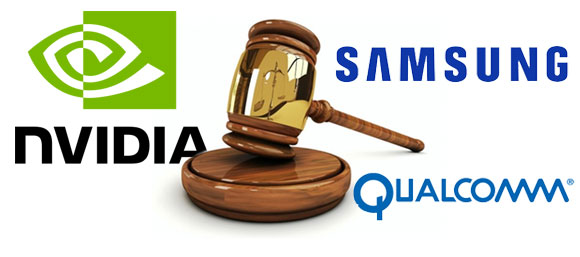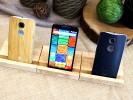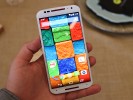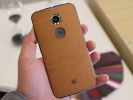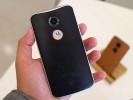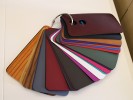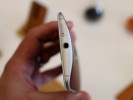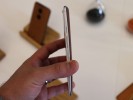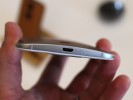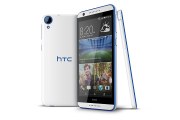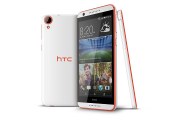After over a year of speculation, we'll finally see the iPhone 6 on the 9th September 2014. One of the biggest questions that people will have is, how does it stack up against the flagship Samsung Galaxy S5? This time around it appears to be a much more close-run thing, at least in terms of size, as the iPhone 6 is set to get bigger. In fact, we're set to see two models a 4.7in version and a 5.5in Phablet iPhone 6L.
In this article we're looking at what we know about the regular iPhone 6 and how it stacks up to its Samsung competition; the iPhone 6L is a larger phone that competes more with the Samsung Galaxy Note 4. Note that all of the iPhone 6 specs are currently rumours, not fact; we won't know details for definite until the 9th September. However, there have been enough leaks to give us detail enough to see how the phones currently stack up against each other.
Build quality
Samsung has steadfastly stuck with plastic as a construction material of choice, and the S5 is no different. It has got a lot better at working with the material as time has gone on, with the S5 a lot better made than the Galaxy S4. It feels tough, the dimpled rear looks great and the phone's available in a range of colours. As good as plastic is, it just doesn't have the same build quality and feel that of a metal case.
Apple's always used a unibody metal exterior for its phones and the iPhone 6 won't be any different. Build quality and design are two hallmark features of Apple products and we're expecting the new phone to be even better. Current leaks and information point at the new phone having a smoother, curved body, with the design cues taken from the iPhone 5C and iPod Nano. We've only seen leaked shells in white and a dark grey, but it's possible that some other colours will also be available.
In terms of size the phones are a lot closer in size than the S5 and iPhone 5S were. The 5.1in screen on the Galaxy S5 obviously makes it a little bigger than the 4.7in iPhone 6, but not by too much. As a released product we know that the Galaxy S5 measures 142x72.5x8.1mm and weighs 145g. We don't have final specs confirmed for the iPhone 6 yet, but all the rumours suggest that it measures 138x66x6.9mm. At this size some people have suggested that the camera will stick out slightly from the case, but we can't imagine that Apple would do something so ugly. We don't have any weight information as a full product sample has yet to be leaked.
One of the big rumours is that the iPhone 6 will use a sapphire glass screen, which is much harder than the Gorilla Glass screen on the Galaxy S5. A video even leaked showing how the iPhone 6's screen can't be scratched with a knife or snapped by hand. Further leaks cast doubt on this, with information that sapphire glass is too hard to produce in volume. We're not quite sure which way it will go yet, but the iPhone 6 certainly won't have worse screen protection than the S5.
Screen
Samsung has put all of its effort into developing Super AMOLED technology, and the screen on the Galaxy S5 is one of the best in the business. With a resolution of 1,920x1,080 it's not the highest-resolution phone (that's the 2,560x1,440 LG G3), but it still looks exceptionally sharp. With brilliant contrast and vivid colours it's hard to make any complaint here.
Apple has always used LCD technology and that looks set to continue with the iPhone 6. The company always uses a high-quality IPS panel and we expect more of the same. Contrast isn't as good as with Super AMOLED, but the screen should be brighter and we're expecting purer whites. Since the iPhone 4 we've had Retina displays: screens where the pixel density is so high that you can't see individual pixels when you view from a normal distance. With a 4.7in 16:9 screen we know that Apple will have to increase resolution in order to maintain the Retina standard; what we don't know is the screen resolution.
So far, we've seen rumours that it will be Full HD (seems unlikely, given previous phone's resolution). A more likely rumour is that the screen will be 1,704x960, which makes scaling from the iPhone 5S easy, so apps will continue to work properly. This could be more and an iPhone 6 resolution of 2,272x1,280 (double the iPhone 5S) feels like a reasonable punt.
Performance
Samsung has a quad-core 2.5GHz Qualcomm Snapdragon 801 CPU in its smartphone, which is really fast completing the SunSpider JavaScript test in just 408ms. Apple has, so far, stuck to dual-core processors with much lower clock speeds: the Apple A7 in the iPhone 5S has a clock speed of 1.3GHz. However, it's not the MHz that counts, but the efficiency.
This dual-core CPU managed the SunSpider test in just 416ms. It was also the world's first 64-bit mobile chip running a 64-bit mobile OS. With the iPhone 6 we're expecting to see the Apple A8 chip, a refined version of the A7. We're expecting it to be a dual-core chip, this time running at 2GHz. Given the highly optimised chip and OS, we're expecting a big performance boost and think that the iPhone 6 will easily be the fastest mobile. It's possible, given this optimisation that the iPhone 6 will stick with 1GB of RAM, while the Galaxy S5 has 2GB.
Camera
The iPhone 5S didn't improve on resolution over the iPhone 5S, but did put in a physically larger sensor to improve quality. With the iPhone 6 we're expecting a bit more. Currently we believe that it may have OIS built-in to reduce blur, particularly in low light where the camera has to use a longer shutter speed. It's suggested that resolution won't improve, with an 8-megapixel model fitted.
The Galaxy S5 has a 16-megapixel sensor. It terms of quality it produced similar results to the iPhone 5S, although its much higher resolution meant that there was a lot more detail in the images. If the iPhone 6 doesn't increase image resolution, we're expecting a similar story. One feature we expect to come over from the iPhone 5S is the dual LED flash, which uses on white and one coloured LED. The combination means that the flash can fire in a range of different colours to match the ambient light and subject, who makes it appear as though the flash wasn't used.
Battery life
We're expecting the iPhone 6 to have 1,900mAh battery, which is bigger than the model in the iPhone 5S. However, that battery has to power a larger display, so it doesn't mean that it will last longer. In fact, we expect battery life to be around the same, which means around 14h of constant video playback with the screen at half brightness. With the Galaxy S5 battery life is ace, lasting more than 17h in our tests. It also has a super power-saving mode to help you squeeze more out of it and a replaceable battery; the iPhone 6 will have an integrated battery that's no user serviceable.
Features
Both the iPhone 6 and Samsung Galaxy S5 are to have fingerprint sensors to unlock the handset. While Samsung's sensor can also be used for PayPal transactions we'll have to wait and see what else the iPhone 6's TouchID system can do.
The S5 is targeted heavily towards fitness, with a hear rate sensor built into the back of the phone. It's also water and dust resistant, and compatible with a wide range of wearable tech, including the Gear 2 and Gear Fit. With the Healthkit app in iOS 8, the iPhone 6 will be able to collect similar information, although it seems that this will come from external devices, rather than built-in sensors.
Operating System
Samsung runs Android 4.4 (KitKat), the current version of the OS, although it will get an upgrade to Android L 5 when that's launched later in the year. This promises a slicker user interface, better performance, better battery life and a raft of new features.
Apple will launch iOS 8 on its new phone. As well as further performance and interface improvements, it adds new features for keeping tabs on your health. It will also add in Continuity, which lets you answer calls from your iPad or Mac, plus use Handoff to move tasks between your phone and Mac. For example, you could start writing an email on your phone and then finish it on your Mac.
Both operating systems are very mature now and, with both phones running the latest versions, there's not a huge amount in it. It will mostly come down to preference and the other devices you own; Continuity, for example, is not much use if you don't have an iPad or Mac, for example.
Specs
Below we've put together a list of specs as they currently stand. Note that the iPhone 6 specs are purely speculation at the moment and are subject to change. That's also the reason why this article has no conclusion or verdict: at the moment the iPhone 6 is purely rumour, so we can only see how it may stack up against the Galaxy S5.
| Manufacturer | Apple | Samsung |
| Model | iPhone 6 | Galaxy S5 |
| HARDWARE |
|---|
| Processor | Dual-core 2GHz Apple A8 | Quad-core 2.5GHz Qualcomm Snapdragon 801 |
| RAM | 1GB | 2GB |
| Screen size | 4.7in | 5.1in |
| Screen resolution | At least 1,704x960 | 1,920x1,080 |
| Screen type | IPS | AMOLED |
| Rear camera | 8 megapixels (OIS) | 16 megapixels |
| Flash | Dual-LED | LED |
| Memory card slot (supplied) | N/A | MicroSD |
| Wi-Fi | 802.11n | 802.11ac |
| Bluetooth | Bluetooth 4.0 | Bluetooth 4.0 |
| NFC | No | Yes |
| Wireless data | 4G | 4G |
| Size | 138x66x6.9mm | 142x72.5x8.1 mm |
| Weight | Unknown | 145g |
| FEATURES |
|---|
| Operating system | iOS 8 | Android 4.4 (KitKat) |
| Battery size | 1,900mAh | 2,800mAh |

